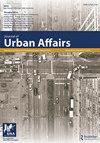Contributors to concentrated poverty of Blacks and Hispanics in metropolitan America, 1980–2020
IF 1.9
3区 经济学
Q2 URBAN STUDIES
引用次数: 0
Abstract
ABSTRACTA longstanding debate asks why African Americans have been disproportionately concentrated in poor neighborhoods. All sides agree that a key contributor is the high level of poverty among Blacks, but they differ on other sources. Has the exodus of a growing Black middle class from the inner city (raising income segregation among Blacks) left the Black poor more isolated? Does persistent high racial segregation hold both middle class and poor Blacks in neighborhoods that are depressed by the high rate of Black poverty? Is poverty in Black neighborhoods mainly due to the presence of poor Black households or poor non-Black neighbors? This study addresses these questions with data for 1980–2020, and extends the analysis also to the case of Hispanic poverty exposure. Longitudinal models and detailed analysis of neighborhood composition by race and income show that the group’s own income composition is the most important predictor of poverty exposure. This effect is compounded by high racial segregation. Within-group income segregation adds to poverty concentration for Blacks but not for Hispanics. Blacks and Hispanics of all income levels live in poorer neighborhoods mainly because of the large share of their Black and Hispanic low-income neighbors, while their white neighbors tend to have higher incomes than they do.KEYWORDS: Segregationpoverty concentrationraceneighborhood Disclosure statementNo potential conflict of interest was reported by the author(s).Additional informationFundingThe work was supported by the National Institutes of Health [1R01HD075785-01A1]; National Science Foundation [SES-2147919]; Russell Sage Foundation [G-2104-31472].Notes on contributorsJohn LoganJohn R. Logan is professor of sociology at Brown University. Much of his research focuses on urban and racial inequality in the U.S., including both contemporary patterns and historical developments since the late 19th Century. He is co-author with Harvey Molotch of Urban Fortunes: The Political Economy of Place (1987). In addition to his own research, he has been active in developing and disseminating census data and maps for public use through projects at Brown University: the Urban Transition Historical GIS Project and the Diversity and Disparities Project.Brian StultsBrian J. Stults, PhD, is a professor in the College of Criminology and Criminal Justice at Florida State University. His research addresses the general issues of race, crime, and community in urban areas, with a particular focus on segregation, racial threat, and spatial and temporal patterns of crime. His work has been published in such journals as the American Journal of Sociology, Criminology, and Journal of Research in Crime and Delinquency.Rachel McKaneRachel McKane is an assistant professor of sociology and the Jack Meyerhoff Chair of American Environmental Studies at Brandeis University. They were previously at Brown University’s Population Studies and Training Center as a postdoctoral research associate in the Spatial Structures in the Social Sciences program. Rachel’s primary research explores the connection between environmental (in)justice and processes of urban change rooted in racial capitalism, city development, and present and historic housing inequality. You can find some of their research in Environmental Research Letters, Environmental Justice, Environmental Sociology, and Cities.1980-2020年美国大都市黑人和西班牙裔人口集中贫困的成因
一个长期争论的问题是为什么非裔美国人不成比例地集中在贫困社区。各方都认为,黑人的高度贫困是一个关键因素,但他们在其他方面存在分歧。越来越多的黑人中产阶级离开市中心(加剧了黑人之间的收入隔离)是否让黑人穷人更加孤立?是否持续的高度种族隔离使中产阶级和贫穷的黑人都生活在因黑人贫困率高而感到沮丧的社区中?黑人社区的贫困主要是因为贫穷的黑人家庭或贫穷的非黑人邻居的存在吗?本研究用1980-2020年的数据解决了这些问题,并将分析扩展到西班牙裔贫困暴露的情况。纵向模型和根据种族和收入对社区构成的详细分析表明,该群体自身的收入构成是贫困暴露的最重要预测因素。这种影响由于高度的种族隔离而加剧。群体内的收入隔离增加了黑人的贫困集中度,但对西班牙裔没有影响。各种收入水平的黑人和西班牙裔都住在较贫穷的社区,主要是因为他们的黑人和西班牙裔低收入邻居占很大比例,而他们的白人邻居往往收入比他们高。关键词:种族隔离贫困集中种族社区披露声明作者未报告潜在的利益冲突。这项工作得到了美国国立卫生研究院的支持[1R01HD075785-01A1];国家自然科学基金[SES-2147919];Russell Sage Foundation [G-2104-31472]。作者简介john R. Logan是布朗大学的社会学教授。他的大部分研究集中在美国的城市和种族不平等,包括当代模式和自19世纪后期以来的历史发展。他与哈维·莫洛奇合著了《城市财富:地方的政治经济学》(1987)。除了自己的研究之外,他还通过布朗大学的城市转型历史地理信息系统项目和多样性与差异项目,积极开发和传播人口普查数据和地图,供公众使用。Brian J. Stults博士是佛罗里达州立大学犯罪学和刑事司法学院的教授。他的研究涉及种族、犯罪和城市社区的一般问题,特别关注种族隔离、种族威胁和犯罪的时空模式。他的作品曾发表在《美国社会学杂志》、《犯罪学杂志》和《犯罪与犯罪研究杂志》等期刊上。雷切尔·麦肯是布兰代斯大学社会学助理教授和杰克·迈耶霍夫美国环境研究主席。他们之前在布朗大学人口研究和培训中心担任社会科学项目空间结构的博士后研究助理。雷切尔的主要研究探讨了环境正义和植根于种族资本主义、城市发展以及现在和历史上的住房不平等的城市变化过程之间的联系。你可以在《环境研究快报》、《环境正义》、《环境社会学》和《城市》中找到他们的一些研究。
本文章由计算机程序翻译,如有差异,请以英文原文为准。
求助全文
约1分钟内获得全文
求助全文
来源期刊

Journal of Urban Affairs
URBAN STUDIES-
CiteScore
5.40
自引率
4.80%
发文量
156
期刊介绍:
Focusing on urban research and policy analysis, the Journal of Urban Affairs is among the most widely cited journals in the field. Published for the Urban Affairs Association, the journal offers multidisciplinary perspectives and explores issues of relevance to both scholars and practitioners, including: - Theoretical, conceptual, or methodological approaches to metropolitan and community problems - Empirical research that advances the understanding of society - Strategies for social change in the urban milieu - Innovative urban policies and programs - Issues of current interest to those who work in the field and those who study the urban and regional environment
 求助内容:
求助内容: 应助结果提醒方式:
应助结果提醒方式:


